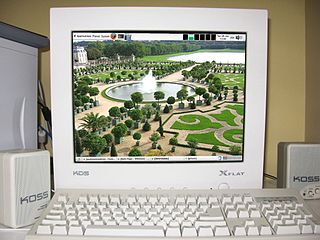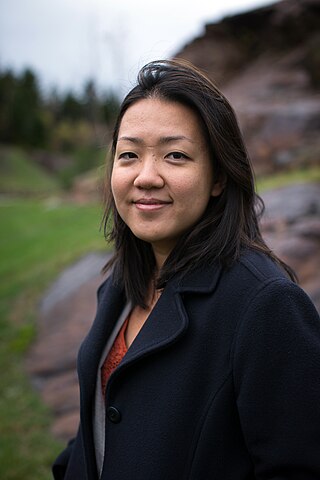Related Research Articles
Ubiquitous computing is a concept in software engineering, hardware engineering and computer science where computing is made to appear seamlessly anytime and everywhere. In contrast to desktop computing, ubiquitous computing implies use on any device, in any location, and in any format. A user interacts with the computer, which can exist in many different forms, including laptop computers, tablets, smart phones and terminals in everyday objects such as a refrigerator or a pair of glasses. The underlying technologies to support ubiquitous computing include the Internet, advanced middleware, kernels, operating systems, mobile codes, sensors, microprocessors, new I/Os and user interfaces, computer networks, mobile protocols, global navigational systems, and new materials.

Home automation or domotics is building automation for a home. A home automation system will monitor and/or control home attributes such as lighting, climate, entertainment systems, and appliances. It may also include home security such as access control and alarm systems.

The American Society of Civil Engineers (ASCE) is a tax-exempt professional body founded in 1852 to represent members of the civil engineering profession worldwide. Headquartered in Reston, Virginia, it is the oldest national engineering society in the United States. Its constitution was based on the older Boston Society of Civil Engineers from 1848.

A smart device is an electronic device, generally connected to other devices or networks via different wireless protocols that can operate to some extent interactively and autonomously. Several notable types of smart devices are smartphones, smart speakers, smart cars, smart thermostats, smart doorbells, smart locks, smart refrigerators, phablets and tablets, smartwatches, smart bands, smart keychains, smart glasses, and many others. The term can also refer to a device that exhibits some properties of ubiquitous computing, including—although not necessarily—machine learning.
Human-centered computing (HCC) studies the design, development, and deployment of mixed-initiative human-computer systems. It is emerged from the convergence of multiple disciplines that are concerned both with understanding human beings and with the design of computational artifacts. Human-centered computing is closely related to human-computer interaction and information science. Human-centered computing is usually concerned with systems and practices of technology use while human-computer interaction is more focused on ergonomics and the usability of computing artifacts and information science is focused on practices surrounding the collection, manipulation, and use of information.
Building automation (BAS), also known as building management system (BMS) or building energy management system (BEMS), is the automatic centralized control of a building's HVAC, electrical, lighting, shading, access control, security systems, and other interrelated systems. Some objectives of building automation are improved occupant comfort, efficient operation of building systems, reduction in energy consumption, reduced operating and maintaining costs and increased security.

Smart environments link computers and other smart devices to everyday settings and tasks. Smart environments include smart homes, smart cities, and smart manufacturing.

In virtual reality (VR), immersion is the perception of being physically present in a non-physical world. The perception is created by surrounding the user of the VR system in images, sound or other stimuli that provide an engrossing total environment.
Adaptive autonomy refers to a suggestion for the definition of the notation 'autonomy' in mobile robotics.
A smart object is an object that enhances the interaction with not only people but also with other smart objects. Also known as smart connected products or smart connected things (SCoT), they are products, assets and other things embedded with processors, sensors, software and connectivity that allow data to be exchanged between the product and its environment, manufacturer, operator/user, and other products and systems. Connectivity also enables some capabilities of the product to exist outside the physical device, in what is known as the product cloud. The data collected from these products can be then analyzed to inform decision-making, enable operational efficiencies and continuously improve the performance of the product.

Daniela L. Rus is a Romanian-American computer scientist. She serves as director of the MIT Computer Science and Artificial Intelligence Laboratory (CSAIL), and the Andrew and Erna Viterbi Professor in the Department of Electrical Engineering and Computer Science (EECS) at the Massachusetts Institute of Technology. She is the author of the books Computing the Future, The Heart and the Chip: Our Bright Future with Robots, and The Mind's Mirror: Risk and Reward in the Age of AI.

Human–computer interaction (HCI) is research in the design and the use of computer technology, which focuses on the interfaces between people (users) and computers. HCI researchers observe the ways humans interact with computers and design technologies that allow humans to interact with computers in novel ways. A device that allows interaction between human being and a computer is known as a "Human-computer Interface".
Urban computing is an interdisciplinary field which pertains to the study and application of computing technology in urban areas. This involves the application of wireless networks, sensors, computational power, and data to improve the quality of densely populated areas. Urban computing is the technological framework for smart cities.
Alice Jane Brush is an American computer scientist known for her research in human-computer interaction, ubiquitous computing and computer supported collaborative work (CSCW). She is particularly known for her research studying and building technology for homes as well as expertise conducting field studies of technology. She is the co-chair of CRA-W from 2014 to 2017.
Cloud robotics is a field of robotics that attempts to invoke cloud technologies such as cloud computing, cloud storage, and other Internet technologies centered on the benefits of converged infrastructure and shared services for robotics. When connected to the cloud, robots can benefit from the powerful computation, storage, and communication resources of modern data center in the cloud, which can process and share information from various robots or agent. Humans can also delegate tasks to robots remotely through networks. Cloud computing technologies enable robot systems to be endowed with powerful capability whilst reducing costs through cloud technologies. Thus, it is possible to build lightweight, low-cost, smarter robots with an intelligent "brain" in the cloud. The "brain" consists of data center, knowledge base, task planners, deep learning, information processing, environment models, communication support, etc.

Ahsan Kareem is the Robert M. Moran Professor of Engineering in the Department of Civil & Environmental Engineering and Earth Sciences (CEEES) at the University of Notre Dame. He is Director of the Nathaz Modeling Laboratory and served as the past Chair at the Department of CEEES at the University of Notre Dame.
Joëlle Coutaz is a French computer scientist, specializing in human-computer interaction (HCI). Her career includes research in the fields of operating systems and HCI, as well as being a professor at the University of Grenoble. Coutaz is considered a pioneer in HCI in France, and in 2007, she was awarded membership to SIGCHI. She was also involved in organizing CHI conferences and was a member on the editorial board of ACM Transactions on Computer-Human Interaction.
Alexandria Boehm is an American scientist whose field of study is civil and environmental engineering. She studies sources, fate and transport of pathogens outside the human body, and coastal water quality. Boehm is a senior fellow at Stanford University's Woods Institute for the Environment, faculty fellow at Stanford University's Center for Innovation in Global Health, and an associate professor in Stanford University's Department of Civil and Environmental Engineering.

Leila A. Takayama is an associate professor of Human–computer interaction at the University of California, Santa Cruz. She has previously held positions at Google X and Willow Garage. She was elected as a World Economic Forum Young Global Leader in 2013.
A software bot is a type of software agent in the service of software project management and software engineering. A software bot has an identity and potentially personified aspects in order to serve their stakeholders. Software bots often compose software services and provide an alternative user interface, which is sometimes, but not necessarily conversational.
References
- ↑ Becerik-Gerber, Burçin; Lucas, Gale; Aryal, Ashrant; Awada, Mohamad; Bergés, Mario; Billington, Sarah L; Boric-Lubecke, Olga; Ghahramani, Ali; Heydarian, Arsalan; Jazizadeh, Farrokh; Liu, Ruying; Zhu, Runhe; Marks, Frederick; Roll, Shawn; Seyedrezaei, Mirmahdi (2022-12-01). "Ten questions concerning human-building interaction research for improving the quality of life". Building and Environment. 226: 109681. Bibcode:2022BuEnv.22609681B. doi: 10.1016/j.buildenv.2022.109681 . ISSN 0360-1323. S2CID 252990777.
- ↑ Becerik-Gerber, Burcin; Lucas, Gale; Aryal, Ashrant; Awada, Mohamad; Bergés, Mario; Billington, Sarah; Boric-Lubecke, Olga; Ghahramani, Ali; Heydarian, Arsalan; Höelscher, Christoph; Jazizadeh, Farrokh; Khan, Azam; Langevin, Jared; Liu, Ruying; Marks, Frederick; Mauriello, Matthew Louis; Murnane, Elizabeth; Noh, Haeyoung; Pritoni, Marco; Roll, Shawn; Schaumann, Davide; Seyedrezaei, Mirmahdi; Taylor, John E.; Zhao, Jie; Zhu, Runhe (2022). "The field of human building interaction for convergent research and innovation for intelligent built environments". Scientific Reports. 12 (1): 22092. Bibcode:2022NatSR..1222092B. doi:10.1038/s41598-022-25047-y. PMC 9769481 . PMID 36543830. S2CID 254997352.
- ↑ California, Gary Polakovic University of Southern (15 January 2019). "How to Improve Communication Between People and Smart Buildings". Electronic Component News. Retrieved 5 March 2019.
- ↑ Stuart, S. C. (28 April 2018). "Are You Ready for Office Buildings With Alexa-Like Personalities?". PCMAG. Retrieved 5 March 2019.
- ↑ Fukumura, Yoko E.; Gray, Julie Mclaughlin; Lucas, Gale M.; Becerik-Gerber, Burcin; Roll, Shawn C. (2021). "Worker Perspectives on Incorporating Artificial Intelligence into Office Workspaces: Implications for the Future of Office Work". International Journal of Environmental Research and Public Health. 18 (4): 1690. doi: 10.3390/ijerph18041690 . PMC 7916505 . PMID 33578736.
- ↑ "People-centric AI for the built environment: Burcin Becerik-Gerber, USC". Artificial-intelligence.video. 9 August 2018. Archived from the original on 6 March 2019. Retrieved 5 March 2019.
- ↑ Takahashi, Dean (3 September 2018). "How researchers are designing smart desks of the future". VentureBeat. Retrieved 5 March 2019.
- ↑ Aryal, Ashrant; Becerik-Gerber, Burcin; Anselmo, Francesco; Roll, Shawn C.; Lucas, Gale M. (2019). "Smart Desks to Promote Comfort, Health, and Productivity in Offices: A Vision for Future Workplaces". Frontiers in Built Environment. 5. doi: 10.3389/fbuil.2019.00076 .
- ↑ https://create.usc.edu/
- ↑ "Innovator Under 35: Burcin Becerik-Gerber, 35". Mit Technology Review. Retrieved 5 March 2019.
- ↑ "Burcin Becerik-Gerber". Turing.ac.uk. Retrieved 5 March 2019.
- ↑ "Viterbi Faculty Directory - Burcin Becerik-Gerber". University of Southern California. Retrieved 24 April 2019.
- ↑ "Scientific Reports".
- ↑ https://www.nationalacademies.org/bice/about
- ↑ https://www.naocon.org
- ↑ "About ELATES". 17 July 2023.
- ↑ "L.A. Area Emmy Awards: KCET Leads Stations with Six Wins". 24 July 2022.
- ↑ "Lives Not Grades". PBS .
- ↑ https://uscglobalinnovation.com
- ↑ Garcia, Kelly (21 December 2023). "Leaders of Influence: Thriving in Their 40s 2023 – Burçin Becerik-Gerber". Los Angeles Business Journal. Retrieved 4 February 2024.
- ↑ "Computing in Civil Engineering Award".
- ↑ "Peurifoy Construction Research Award".